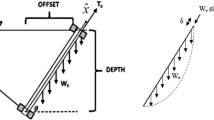Abstract
An upper-bound solution is derived for the problem of the tearing of a metal plate by a rigid wedge. These newly proposed formulas, with no fracture parameters being used, provide an explanation to the problem of plate tearing, which is a phenomenon that occurs in the process of ship grounding. This paper starts with the proposition of a new kinematic model. Based on the fact that in many experiments there is no evidence of cracks extending ahead of the wedge tip, this new kinematic model assumes no separation between the wedge tip and the crack tip in the plate. Another characteristic of this model is that out-of-plane deformation is assumed for the region around the tip, which correlates well with the experimental observations. Rupture of the metal plate is assumed to occur ahead of the wedge tip due to ductile failure. In the case of longitudinally stiffened panels, an equivalent plate thickness is employed to take the effect of stiffeners into consideration. From comparisons of calculations with existing experimental results, it is clear that the present upper-bound solution is effective in predicting resistance force and energy absorption in the process of plate tearing, and that it can provide predictions that are close to those obtained from empirical formulas and from the theoretical formulas of Wierzbicki and Thomas, who assume that cracks run ahead of the wedge tip.
Similar content being viewed by others
References
Akita Y, Ando N, Fujita Y, et al. (1972) Studies on collisionprotective structures in nuclear powered ships. Nucl Eng Des 19:365–401
Vaughan H (1978) Bending and tearing of plate with application to ship-bottom damage. Nav Archit 97:97–99
Vaughan H (1980) The tearing strength of mild steel plate. J Ship Res 24:96–100
Woisin G (1982) Comments on Vaughan: The tearing strength of mild steel plate. J Ship Res 26:50–52
Jones N, Jouri WS (1987) A study of plate tear for ship collision and grounding damage. J Ship Res 31:253–268
Lu G, Calladine CR (1990) On the cutting of a plate by a wedge. Int J Mech Sci 32:293–313
Wierzbicki T, Thomas P (1993) Closed-form solution for wedge cutting force through thin metal sheets. Int J Mech Sci 35:209–229
Paik JK (1995) Cutting of a longitudinal stiffened plate by a wedge. J Ship Res 38:340–348
Astrup OC, Skeie G (1994) Tearing of ship plates by a narrow wedge. DNVR report 93-2080, DNV
Author information
Authors and Affiliations
About this article
Cite this article
Ohtsubo, H., Wang, G. An upper-bound solution to the problem of plate tearing. J Mar Sci Technol 1, 46–51 (1995). https://doi.org/10.1007/BF01240012
Received:
Accepted:
Issue Date:
DOI: https://doi.org/10.1007/BF01240012



